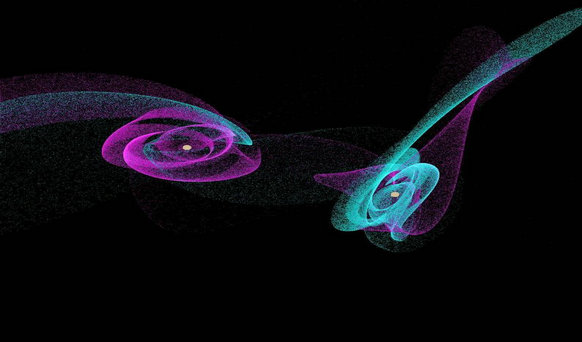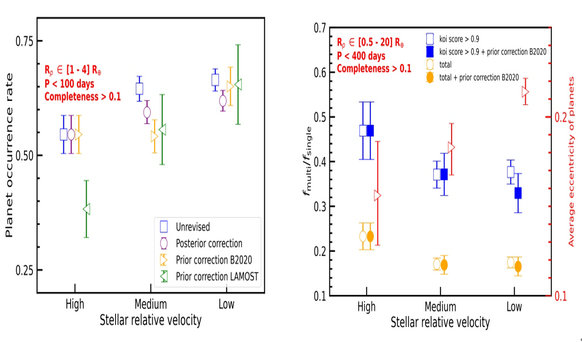Correlation between planet occurrence and stellar dynamics discovered via LAMOST-Gaia data
A new study carried out by the Associated Prof. Hui-Gen Liu, PhD candidate Yuan-Zhe Dai and collaborators from Nanjing University showed the evidence that the planet occurrence rate correlates with the stellar dynamical history, utilizing the latest Gaia astrometric data and LAMOST spectroscopic data. The results have been published in The Astronomical Journal.
Current theories of star formation suggest that stars form in clustered environments and planets are born in protoplanetary disks around the stars. Therefore, the formation and evolution of planets are closely related to the star formation in the Milky Way.
Observation shows that stars form in environments of great diversity. Planets’ formation and evolution in such different environments is an open issue. For example, in clusters, massive stars with strong radiation will photo-evaporate nearby gas. More interestingly, close stellar-flyby events occur frequently (Figure 1). Studying how these dynamics and radiation environments of planet host stars influence planetary systems can help us understand how planets form and evolve on a large scale in the Milky Way.

Figure 1: Screenshot of a simulation of the interaction between flyby stars and protoplanetary disks. (https://www.physics.utah.edu/~bromley/flyby/flyby7v.jpg)
Limited by the observed samples of planets in clusters, most studies on how the environments influence the planetary systems are theoretical. However, with the help of Gaia DR2, previous works show that stars in clusters can maintain low relative velocities for billions of years. These studies indirectly suggest that stellar dynamics environments play an important role in shaping planetary systems.
Based on the Gaia-Kepler Stellar Properties Catalog, Yuan-Zhe Dai, the first author of this work, together with collaborators, calculated the two-dimensional velocities of the single stars in main-sequence, and divided them into three groups according to their relative velocities, i.e., high-V, medium-V, and low-V stars. Different stellar groups show different distributions of properties. Meanwhile, stellar properties are closely related to planet occurrence. For example, planet occurrence rate increases with increasing metallicity. To obtain robust results, such bias must be corrected. Fortunately, LAMOST provides robust metallicity measurement of stars which can be used to correct the influence of metallicity on planet occurrence rate.
The researchers finally found that super-Earth and sub-Neptune are easier to form or survive around low-V stars, while high-V stars tend to have more multiple-planets systems and a lower average eccentricity (Figure 2).

Figure 2: Left: the correlation between planet (1-4 Earth radii) occurrence rate and stellar relative velocity. Right: the correlation of multiplicity (blue and orange) and eccentricity (red triangle) with stellar relative velocity. (Credit: Dai et al. 2021)
The results can be explained by stellar dynamics. High-V stars escape from clusters in the early stage, experiencing less gravitational perturbation. While low-V stars retain in the clusters until the dispersal of the cluster, which suggests that they may experience secular gravitational perturbations. The perturbations can enhance the formation of close-in planets, e.g. hot super-earths and hot Neptunes. Thus low-V stars, which stay in clusters for longer time, tend to have a higher occurrence rate of hot planets with 1-4 Earth radii. For multi-planet system around the low-V star, mutual inclination becomes larger, coupled with the increasing eccentricity due to perturbations. Because it is blind for transit method to discover planets with high mutual inclination, the fraction of multi-planet systems around low-V stars will be lower than that of high-V stars.
"This work correlated planetary formation and evolution to the dynamic evolution of stars by observing the velocity of stars, and open a new window for studying the co-evolution of stellar dynamics and planetary systems," said Hui-Gen Liu, the corresponding author of the paper.
The paper can be accessed at https://iopscience.iop.org/article/10.3847/1538-3881/ac00ad